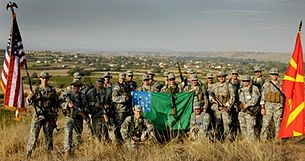Vermont National Guard
Perhaps the most noteworthy example of this occurred in 1775, when the Green Mountain Boys became part of the Continental Army, and the committee of safety selected Warner over Allen as colonel and commander.
[8] Since Vermont was not part of the British colonies that declared independence, the Continental Congress did not automatically accept Allen's and Warner's request for the Green Mountain Boys to be directly accessed into the army.
[10][11] When Allen was denied the command, he met with Major General Philip Schuyler and offered to serve in any capacity—with a commission or without, with pay or without.
[22] U.S. forces, including the Vermont Militia, remained encamped near Plattsburgh until they returned home in December, and Chittenden took no action against Davis.
U.S. House members from Kentucky who supported the War of 1812 introduced resolutions calling for criminal charges to be pursued against Chittenden, which were never acted on, but Vermont public opinion on the war had changed and Vermonters demonstrated their displeasure with Chittenden's stance by defeating his bid for a third one-year term in 1815.
Subsequent changes to Vermont law conferred this appointment power on the state legislature, which still elects the adjutant general every two years.
The Vermont adjutant general's office was marked in the 1820s and 1830s by efforts to reenergize the militia after interest started to lapse following the War of 1812.
In the 1830s and 1840s militia activity nationwide was on the wane, largely the result of the long period of relative peace that followed the War of 1812.
From the late 1830s on, the office worked in conjunction with the faculty of Norwich University to reorganize and obtain funding for the militia, and convened annual meetings of like-minded individuals to plan ways to increase participation.
H. H. Baxter, Vermont's adjutant general in the late 1850s and early 1860s, was commended for taking measures to prepare the militia for mobilization in anticipation of the Civil War.
During the Flood of 1927, the Vermont National Guard overcame the downing of telephone and telegraph lines by following Johnson's directive to operate on their own initiative during recovery efforts, and the National Guard took part in evacuations of people from flooded areas, clearing roads, and providing food, water and other emergency aid.
In the early to mid-1930s Johnson worked to maintain funding for the National Guard while states and the federal government struggled with the loss of revenue caused by the Great Depression.
These efforts to preserve the Guard's readiness and force structure were later acknowledged by historians to have played an important part in the Army's rapid response after the US entered World War II.
The 2nd Battalion of the 172nd Infantry Regiment earned a Presidential Unit Citation for combat actions during the Battle of the Ipo Dam, Luzon in mid May 1945.
Several Vermont National Guard organizations were activated for Operation Desert Storm, including the 131st Engineer Company, which served in Southwest Asia.
[32] In 1997 the Vermont National Guard made history when Martha Rainville became the first woman to ever serve as a state adjutant general.
[33] The Vermont National Guard also continued to perform its state mission, including responding after a massive ice storm in 1998.
[34] Following the September 11, 2001 terrorist attacks, Vermont Army and Air National Guard members performed missions in support of Operations Noble Eagle, Enduring Freedom in Afghanistan and Iraq.
In 1894 the Vermont General Assembly authorized purchase of a portion of Fort Ethan Allen for use as a National Guard training site.
This site, christened the State Military Reservation, was named Camp Olympia for the flagship of George Dewey, a native Vermonter.
On Friday November 14, 2008, they retired the longest flying Block 25 F-16C in the United States, tail number 83-1165, which will go on display in Vermont before eventually being moved to the Smithsonian Air & Space Museum.


